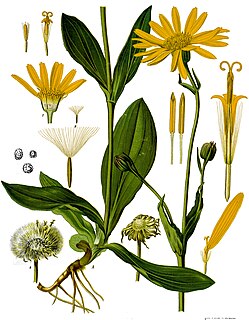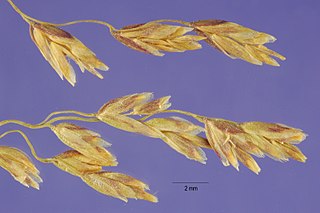
Arnica is a genus of perennial, herbaceous plants in the sunflower family (Asteraceae). The genus name Arnica may be derived from the Greek arni, "lamb", in reference to the plants' soft, hairy leaves. Arnica is also known by the names mountain tobacco and confusingly, leopard's bane and wolfsbane—two names that it shares with the entirely unrelated genus Aconitum. It can have adverse reactions and you should proceed with caution.

Leymus is a genus of plants in the grass family Poaceae (Gramineae). It is widespread across Europe, Asia, and the Americas.

Eriophorum is a genus of flowering plants in the family Cyperaceae, the sedge family. They are found throughout the arctic, subarctic, and temperate portions of the Northern Hemisphere in acid bog habitats, being particularly abundant in Arctic tundra regions.

Harrimanella is a genus of flowering plant in the heath family Ericaceae, with a single species, Harrimanella hypnoides, also known as moss bell heather. It was originally named Cassiope hypnoides by Linnaeus (1737) in his Flora Lapponica, but Harrimanella hypnoides is now the accepted name at Integrated Taxonomic Information System. The species name hypnoides means 'like Hypnum ', which is a genus mosses.

Koeleria is a common and widespread genus of plants in the grass family, found on all continents except Antarctica and on various oceanic islands. It includes species known generally as Junegrasses.

Helictotrichon, or alpine oatgrass, is a genus of perennial flowering plants in the grass family. The genus name comes from the Greek heliktos meaning twisted, and trichos meaning spine, referring to the shape of the awn.

Glyceria is a widespread genus of grass family common across Eurasia, Australia, North Africa, and the Americas.

Pleuropogon is a genus of Arctic and North American plants in the grass family known generally as semaphore grass.

Circumpolar peoples and Arctic peoples are umbrella terms for the various Indigenous peoples of the Arctic.

Oeneis jutta, the Jutta Arctic or Baltic grayling, is a species of butterfly in the subfamily Satyrinae with a Circumboreal distribution. It occurs in bogs and tundra in the north of Europe, the Baltic states, the Urals, Siberia, northern Kazakhstan, the Russian Far East, northern Mongolia, northeastern China, North Korea, and northern North America. Larvae feed on Carex and Eriophorum, possibly also Glyceria, Molinia, and Juncus. Ledum palustre is the preferred nectar plant of the adult butterflies. The species has one generation every one or two years, depending on the location.

Arctophila is a genus of Arctic and Subarctic plants in the grass family. The only known species is Arctophila fulva, commonly known as pendant grass, native to northern parts of Eurasia and North America.

Arctagrostis is a genus of Arctic and Subarctic plants in the grass family, native to colder parts of Europe, Asia, and North America.

Catabrosa is a small but widespread genus of plants in the grass family native to temperate areas of Eurasia, the Americas, and a few places in Africa.
Dupontia is a genus of Arctic and Subarctic plants in the grass family.
Luzula wahlenbergii, commonly known as Wahlenberg's woodrush or reindeer wood-rush, is a perennial species of plant in the genus Luzula of the (rush) family Juncaceae.
Pucciphippsia is a genus of Arctic plants in the grass family, reported from Greenland, Svalbard, and Magadan.

Oeneis bore, the white-veined Arctic or Arctic grayling, is a butterfly, a species of Satyrinae that occurs in North America and Asia.
Festuca edlundiae, commonly known as Edlund's fescue, is a native, perennial tufted grass found in Alaska, Canadian arctic islands, northern Greenland, far eastern arctic Russia and Svalbard. The specific name honours Doctor Sylvia Edlund, a Canadian botanist. It was first described by Susan Aiken, Laurie Consaul and Leonard Lefkovitch in 1995.

Cochlearia groenlandica, known in English as Danish scurvygrass or Greenland scurvy-grass, is a flowering plant of the genus Cochlearia in the family Brassicaceae.















